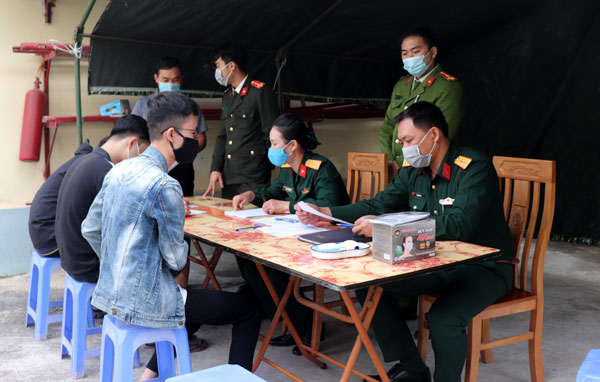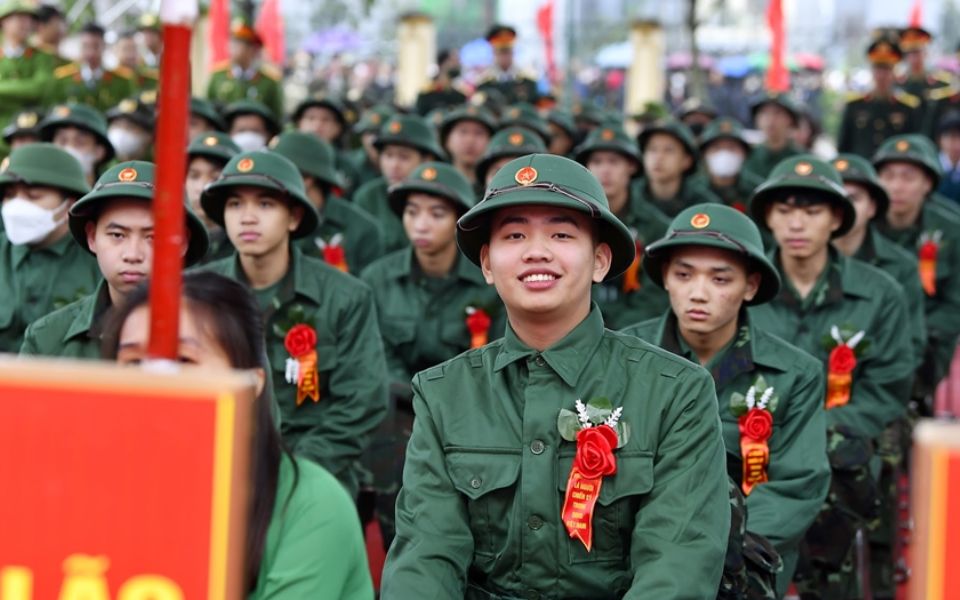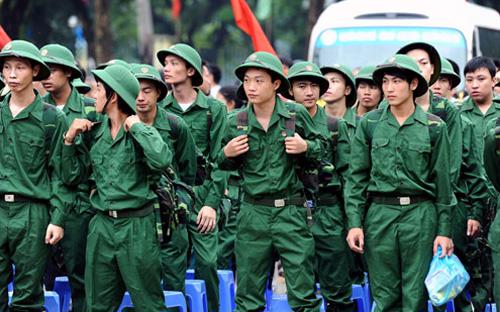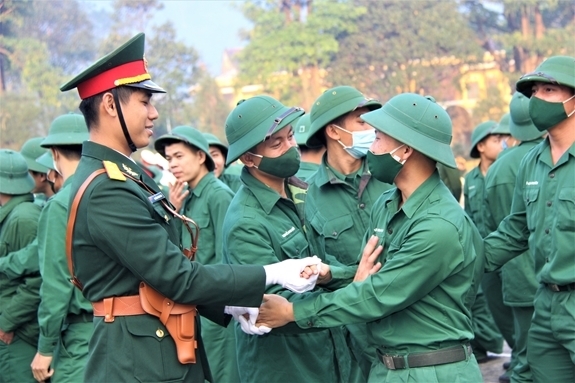Standards for classification according to physical fitness when examining military service as of January 1, 2024 in Vietnam (Circular 105/2023/TT-BQP)
What are the standards for classification according to physical fitness when examining military service as of January 1, 2024 in Vietnam? - My Anh (Kien Giang)

Standards for classification according to physical fitness when examining military service as of January 1, 2024 in Vietnam (Circular 105/2023/TT-BQP) (Internet image)
Regarding this issue, LawNet would like to answer as follows:
On December 6, 2023, the Minister of National Defense issued Circular 105/2023/TT-BQP regulating health standards and medical examinations for subjects under the management of the Ministry of National Defense.
1. Standards for classification according to physical fitness during medical examinations for military service as of January 1, 2024 in Vietnam (Circular 105/2023/TT-BQP)
According to Section I, Appendix I, issued with Circular 105/2023/TT-BQP, the standards for classification according to physical fitness when examining military service from January 1, 2024 are as follows:
|
HEALTH TYPE |
MALE |
FEMALE |
BOTH |
|||
|
Height (cm) |
Weight (kg) |
Bust (cm) |
Height (cm) |
Weight (kg) |
BMI |
|
|
1 |
≥ 163 |
≥ 51 |
≥ 81 |
≥ 154 |
≥ 48 |
18.5 - 24.9 |
|
2 |
160 -162 |
47 - 50 |
78 - 80 |
152 - 153 |
44 - 47 |
25 - 26.9 |
|
3 |
157 -159 |
43 - 46 |
75 - 77 |
150 - 151 |
42 - 43 |
27 - 29.9 |
|
4 |
155 -156 |
41 - 42 |
73 - 74 |
148 - 149 |
40 - 41 |
<18.5 or 30 - 34.9 |
|
5 |
153 -154 |
40 |
71 - 72 |
147 |
38 - 39 |
35 - 39.9 |
|
6 |
≤ 152 |
≤ 39 |
≤ 70 |
≤ 146 |
≤ 37 |
≥ 40 |
2. Regulations on medical examination for military service according to Circular 105/2023/TT-BQP in Vietnam
Regulations on medical examination for military service according to Article 8 of Circular 105/2023/TT-BQP are as follows:
- Military service medical examination is performed by the district-level Military Service Medical Examination Council according to the provisions of Clause 1, Article 40 of the Law on Military Service 2015, including:
+ The Chairman of the Council is the Director of the district-level Medical Center or the Director of the district-level general hospital;
+ The Vice Chairman of the Council is the Deputy Director in charge of expertise of the district-level Medical Center or Deputy Director of the district-level general hospital;
+ Standing Member and Secretary of the Council, who is an advisory officer in charge of implementing state management of health at the district level;
+ Members are officials and employees of agencies and units, including: District-level Medical Center, district-level general hospitals (if any), district-level health agencies, military medical units of the district-level military command, and representatives of relevant units; In cases of necessity, it is possible to increase the human resources of provincial-level medical officers and staff or the military medical staff of the Provincial Military Command, as decided by the Chairman of the Provincial Military Service Council;
+ Council members ensure enough departments and specialties as prescribed in Clause 5, Article 8 of Circular 105/2023/TT-BQP and must have a practicing certificate or practicing license appropriate to the tasks prescribed by law on medical examination and treatment.
- Duties of the Military Service Medical Examination Council
+ Responsible to the District Military Service Council for implementing health examinations, classifications, and health conclusions for each citizen called to enlist;
+ Summarize and report health examination results to the District Military Service Council and the Department of Health of provinces and centrally run cities (hereinafter referred to as the Provincial Department of Health); Hand over all health records to the District Military Service Council (through the health agency at the same level).
- Duties of members of the Military Service Medical Examination Council
+ The Chairman of the Council is responsible before the district-level Military Service Council for concluding the health of citizens who are called to perform military service; Managing the activities of the Council, including: developing and disseminating health examination plans; guiding regulations on health standards; responsibilities, tasks, working principles, and assignment of tasks to each Council member; Organize consultations and send medical examinations for citizens performing military service to medical facilities in case of necessity; directly classify health and sign health cards for military service; Organize lessons learned from medical examinations for military service.
The Chairman of the Council is allowed to use the seal of the agency or unit he works for while performing his duties;
+ The Vice Chairman of the Council replaces the Chairman of the Council in his absence; Participate in health examinations, consultations, and chair Council meetings when authorized;
+ Standing Member, cum Secretary of the Council, is responsible for estimating, synthesizing and finalizing funds, medicine, and consumable supplies for military service medical examination; Preside and coordinate with Council members to prepare facilities, equipment, support forces, health records, and documents for the Council to carry out its tasks; Participate in health examinations, consultations, and Council meetings; registration; statistical reporting according to Form 2b and Form 2l, Appendix VI issued with Circular 105/2023/TT-BQP;
+ Council members directly examine and are responsible for the quality of health examinations and conclusions according to assigned tasks; propose to the Chairman of the Council to order tests according to professional requirements to make accurate health conclusions; Participate in consultations and Council meetings when they are convened.
- Working Principles of the Military Service Medical Examination Council
+ The Council works according to collective principles, deciding on issues by majority;
+ In the event that the members of the Council do not agree on the health classification, the Chairman of the Council shall record the conclusion on the health form according to the opinion of the majority. In cases of equal voting, the decision will be made according to the side with the vote of the Chairman of the Council. Disagreements must be fully recorded in the minutes, signed by each Council member.
- Health examination content
+ Physical examination; Clinical specialties: eyes, ENT, maxillofacial, internal medicine, neurology, psychiatry, surgery, dermatology, obstetrics, and gynecology (for women);
+ Paraclinical examination: Blood formula; blood group (ABO); liver function (AST, ALT); kidney function (Urea, Creatinine); blood sugar; hepatitis B virus (HBsAg); hepatitis C virus (Anti-HCV); HTV; total urine. (10 parameters); general abdominal ultrasound; ECG; cardiorespiratoire droite ray; urine test detects drugs. The Chairman of the Council prescribes additional tests according to professional requirements to make accurate health conclusions.
- Health examination process
+ Prepare a list of citizens for examination;
+ Notify the time and location of the health examination (Order the health examination);
+ Organize health examinations according to the contents specified in Clause 5, Article 8 of Circular 105/2023/TT-BQP and carry out them in 2 rounds: physical examination, clinical and paraclinical examination, HIV, and drug screening. drug.
During physical and clinical examination, if a citizen does not meet one of the health standards specified in Clause 1 of Article 4 of Circular 105/2023/TT-BQP, the Council member directly conducts the examination and reports to the Chairman of the Council to decide to stop the examination.
Only blood and urine tests are conducted; HIV and drug testing is done for citizens who meet health standards after a physical examination, clinical examination, ultrasound, electrocardiogram, and chest X-ray.
Organize HIV counseling and testing according to the provisions of the law on HIV/AIDS prevention and control for cases meeting health standards;
+ Complete the military service health card according to Form 3, Appendix V issued with Circular 105/2023/TT-BQP;
+ Summarize and report the results of the medical examination for military service according to Form 2b, Appendix VI, issued with Circular 105/2023/TT-BQP.
- Health examination period: from November 1 to December 31 every year. The Ministry of National Defense adjusts the time when necessary.
- Organize health clinics
+ The arrangement of examination rooms must follow the principle of one-way, closed, and convenient for the examiner and ensure minimum conditions for examination for each specialty: physical fitness, eyes, ENT, maxillofacial, internal medicine, neurology, psychiatry, surgery, dermatology, obstetrics, and gynecology (for women). Each specialty has at least one room. Psychiatric, surgical, dermatology, and obstetrics and gynecology screening clinics must ensure confidentiality and seriousness and avoid noise.
Order of health examination line: Waiting place for examination; register for examination; physical examination; measure pulse and blood pressure; ECG; supersonic; surgery; dermatology; eye, ear, nose, and throat; dentomaxillofacial; medical; nerve; mental; obstetrics and gynecology (if female); conclude. Testing and X-rays are arranged in separate areas, but the results must be guaranteed before the Chairman of the Council concludes.
+ Minimum medical equipment and instruments of the Health Examination Council according to the List in Appendix IV issued with Circular 105/2023/TT-BQP.
- For localities with district-level general hospitals, the general hospitals are responsible for implementing the contents specified in Article 8 of Circular 105/2023/TT-BQP.
More details can be found in Circular 105/2023/TT-BQP taking effect on January 1, 2024, replacing Joint Circular 16/2016/TTLT-BYT-BQP.
- Key word:
- military service
- in Vietnam
- Number of deputy directors of departments in Vietnam in accordance with Decree 45/2025/ND-CP
- Cases ineligible for pardon in Vietnam in 2025
- Decree 50/2025 amending Decree 151/2017 on the management of public assets in Vietnam
- Circular 07/2025 amending Circular 02/2022 on the Law on Environmental Protection in Vietnam
- Adjustment to the organizational structure of the Ministry of Health of Vietnam: Certain agencies are no longer listed in the organizational structure
- Vietnam aims to welcome 22-23 million international tourists in Vietnam in 2025
-

- Time for mandatory military service enlistment ...
- 13:33, 30/01/2025
-

- Cases of temporary postponement of military service ...
- 17:48, 08/11/2024
-

- Ministry of National Defense of Vietnam provides ...
- 12:26, 08/11/2024
-

- Emergency response and search and rescue organizations ...
- 10:29, 11/09/2024
-

- Handling of the acceptance results of ministerial ...
- 09:30, 11/09/2024
-

- Notable new policies of Vietnam effective as of ...
- 16:26, 11/04/2025
-
.Medium.png)
- Notable documents of Vietnam in the previous week ...
- 16:21, 11/04/2025
-
.Medium.png)
- Notable documents of Vietnam in the previous week ...
- 16:11, 02/04/2025
-
.Medium.png)
- Notable new policies of Vietnam to be effective ...
- 16:04, 02/04/2025
-
.Medium.png)
- Notable new policies of Vietnam effective from ...
- 14:51, 21/03/2025

 Article table of contents
Article table of contents
